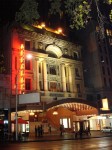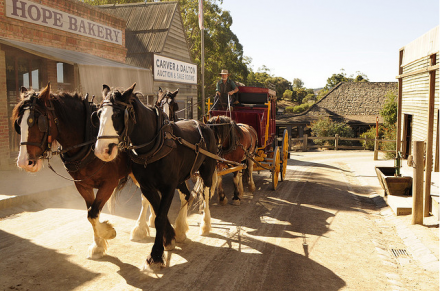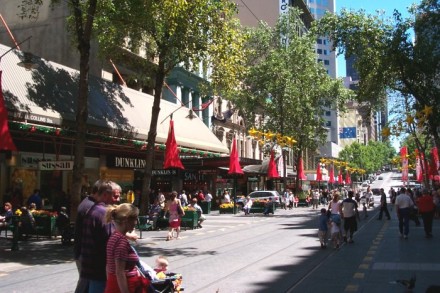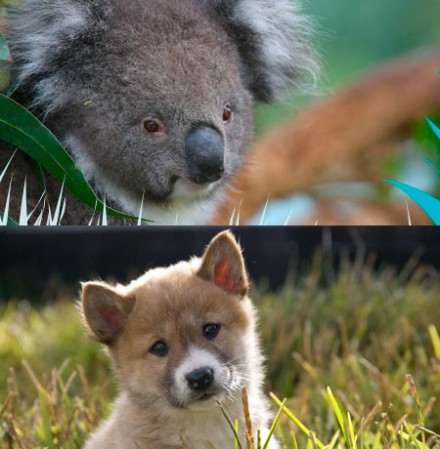Sejauh pengamatan saya, kok nggak ada ya travel guide yang menyajikan tujuan-tujuan wisata dengan ringan tapi komprehansif; dengan bahasa yang tidak kaku dan bertujuan untuk menginformasikan (bukan menjual) serta memberikan informasi yang tidak umum dan unik. Lalu sempat kepikiran, kenapa tidak buat sendiri? Saya sudah sempat membuat posting pendek tentang Jogja, dan sepertinya Melbourne adalah kota kedua yang cukup menarik untuk diceritakan.
Melbourne, kota kedua terbesar di Australia setelah Sydney memang pantas disebut garden city karena dimana-mana selalu ada taman. Kesan pertama waktu saya disana cukup standar: kota ini hijau sekali. Standar piknik disana biasanya selalu disertai dengan membakar steak, karena BBQ sudah menjadi budaya bangsa Australia. Karena saking segitunya sama BBQ, pemerintah bahkan menyediakan bakaran BBQ yang diperasikan dengan listrik: Anda cukup menekan tombok power dan bakaran akan panas selama beberapa menit. Nah berikut ini adalah sejumlah tempat wisata yang cukup asyik untuk dikunjungi disana:
Soverign Hill, Ballarat
Ini tujuan wisata yang sayang kalau dilewatkan. Soverign Hill adalah sebuah kota penghasil emas di Australia dari pertengahan tahun 1800 yang direka ulang sehingga menjadi obyek wisata yang membawa anda ke masa lalu. Bayangkan rumah-rumah dan toko-toko kuno di jalan tanah yang dilalui orang-orang berbusana model abad 19 dan kereta kuda. Anda bisa mengikuti pelajaran sekolah dari jaman itu (bahkan belajar menulis dengan pena celup), melihat cara kerja mesin uap kuno (yang masih berjalan dengan sempurna), mendulang emas di sungai, bermain boling jaman dulu sampai melihat perkemahan imigran Cina. Jangan lupa untuk mencicipi caramel fudge dan lolipop yang dijual di toko permen di Main Street. Kalau ingin menguji kemampuan anda mendulang emas, sebaiknya anda tidak ke Souverign Hill pada saat musim dingin karena air sungainya sangat membekukan tangan.
Bourke Street Walk
Ini sepertinya tujuan wajib bagi pelancong karena terletak di City (Central Business District-nya Melbourne). Di Bourke Street ada berbagai macam toko dan pusat suvenir 2 dolar-an yang cocok untuk oleh-oleh. Bagi yang gila belanja, dua departement store besar: Myer dan David Jones juga terletak disini.
Akan tetapi yang paling menarik di Bourke Street adalah pengamen jalanan yang memainkan berbagai jenis musik, mulai dari genre Spanish Guitar hingga Jazz. Jangan salah, mereka tidak minta uang receh; melainkan menawarkan CD album mereka. Kalau anda berkunjung ke Melburne pada musim natal, Myer selalu menyulap jendela etalase mereka menjadi rangkaian petunjukan audio-animatronics yang bertema natal seperti Rudolph the Red Nose Reindeer dan How the Grinch Stole Christmas.
South Yarra
South Yarra yang terletak di selatan sungai Yarra adalah kampungnya orang kaya Melbourne. Mentengnya Melbourne lah. Coba lewat sana sewaktu musim gugur, nanti rumah-rumah megah yang kebanyakan ber-arsitektur kolonial akan nampak romantis dihiasi dengan guguran daun yang merah kecoklatan.
Sehabis itu Anda bisa mencari barbeque spot di tepi sungai Yarra, lalu memasak BBQ steak yang lezat menggunakan panggangan yang sudah disediakan gratis di sepanjang tepi sungai tersebut. Cukup beli daging sapi (atau kambing) di supermarket terdekat, bakar dengan mentega dan irisan bawang bombay; beri bumbu garam + merica dan makan bersama saus BBQ (gak usah pake nasi!). Daging sapi dan kambing Australia itu sudah cukup lezat, sehingga tidak perlu diberi bermacam-macam bumbu.
Old Melbourne Gaol
 Bukan favorit saya, tapi menurut adik saya cukup pantas untuk dikunjungi. Old Melbourne Gaol adalah penjara pertama di Australia. Di tempat ini, Robin Hood Australia Ned Kelly dipenjara dan akhirnya dihukum gantung. Yang tidak saya suka… tempatnya menyeramkan sekali. Sel-selnya yang singup dan lembab… sepertinya hantu-hantu para narapidana dari akhir abad 19 masih berkeliaran disitu.
Bukan favorit saya, tapi menurut adik saya cukup pantas untuk dikunjungi. Old Melbourne Gaol adalah penjara pertama di Australia. Di tempat ini, Robin Hood Australia Ned Kelly dipenjara dan akhirnya dihukum gantung. Yang tidak saya suka… tempatnya menyeramkan sekali. Sel-selnya yang singup dan lembab… sepertinya hantu-hantu para narapidana dari akhir abad 19 masih berkeliaran disitu.
Disana ada juga cambuk (yang telah direndam dengan air garam supaya lebih sakit kalau dipakai buat mencambuk), alat-alat hukuman bahkan cetakan kepala dari narapidana yang telah dihukum mati yang terbuat dari gips. Cetakan itu digunakan untuk penelitian perilaku kriminal yang diduga berhubungan dengan bentuk kepala.
Phillip Island Pinguin Parade

Cocok buat pecinta binatang. Setiap sore, burung pinguin yang seharian berada di laut pulang kembali ke daratan. Di Phillip Island, Anda bisa melihat langsung burung-burung inosen ini berbaris menuju daratan dan menerobos melewati kaki Anda. Ada yang masih single, ada yang bawa anaknya. Kalau Anda ingin melihat pingun dari jarak yang paling dekat, datanglah paling awal dan ambil tempat duduk yang dekat dengan tepi pantai dan dekat dengan jalur para pinguin itu.
Melbourne Festival
Diadakan tiap Oktober hingga November, gabungan festival pertanian, seni dan perdagangan. Ada kontes anjing shepherd, kontes domba, kontes kucing berbagai ras, tumpek blek jadi satu. Ada ratusan stand-stand yang menjual pernak-pernik sampai makanan. Saya dulu saya mborong peralatan sulap Mr Magic disana. Jangan pegang bulu domba yang akan naik ke pentas karena kemungkinan domba tersebut sudah disisir berjam-jam (adik saya pernah dimarahi karena pegang bulu domba).
Healesville Sanctuary
Ingin lihat Koala dalam jarak dekat atau bersalaman dengan Kangguru? Wah anda harus coba ke Healesville Sanctuary. Berbeda dengan Melbourne Zoo, di tempat ini para binatang dibiarkan hidup bebas alias tidak dikandang, sehingga anda dapat berinteraksi langsung dengan para binatang (kecuali dengan Koala karena mereka tidur 20 jam perhari).
Jangan memberi makan binatang yang ada disitu karena mereka pada umumnya memiliki diet tertentu (kakak sepupu saya pernah panik luar biasa karena memberi roti tawar kepada segerombolan burung Ibis, untungya burung tersebut tidak apa-apa). Disini juga disediakan panggangan BBQ, jadi anda bisa menutup wisata flora dan fauna dengan menyantap… fauna lain.
Nonton Teater
 Melbourne dicanangkan untuk menjadi pusat hiburan teater di belahan bumi bagian selatan. Kurang lebih ekivalennya Broadway di New York dan West-End di London. Oleh karena itu disana sering ada production musical yang ngetop seperti The Phantom of The Opera, Sunset Blvd., dan Beauty and the Beast.
Melbourne dicanangkan untuk menjadi pusat hiburan teater di belahan bumi bagian selatan. Kurang lebih ekivalennya Broadway di New York dan West-End di London. Oleh karena itu disana sering ada production musical yang ngetop seperti The Phantom of The Opera, Sunset Blvd., dan Beauty and the Beast.
Nah, nonton musical adalah alternatif kegiatan malam yang menarik, mengingat sejumlah biasanya toko sudah tutup. Coba cari brosur pertunjukan yang sedang berjalan di Regent Theatre atau Princess Theatre; lalu anda bisa mulai reservasi tiket. Musical sedikit lebih casual (dan mudah lebih dicerna) daripada Opera sehingga anda tidak perlu mengenakan gaun malam atau jas pinguin. Cukup busana yang rapih dan kasual. Yang jelas matikan hp anda (dan semua benda yang mengeluarkan suara), jangan ke wc selama pertunjukan (anda dapat ke wc pada saat istirahat), serta jangan berbicara selama pertunjukan kalau tidak ingin didamprat penonton yang lain.
Jalan Tuhan
Apakah anda sudah di Jalan Tuhan? Saya pernah. Tapi yang saya maksud adalah Tuhan Street yang terletak di suburban Melbourne. Lucu buat cerita-cerita kalau anda berfoto di depan sign jalan itu, teruatam akalau anda punya terlalu banyak waktu luang. Setelah itu Anda bisa main dulu ke Chadstone Mall yang merupakan mall terbesar di Victoria. Di area foodcourtnya ada warung souvlaki (semacam kebab khas Yunani) yang enak.
Como House
Melbourne punya banyak mansion yang dulu ditinggali oleh tuan tanah kaya raya. Mengunjungi rumah-rumah megah itu Anda bisa membayangkan kemegahan gaya hidup cream society Melbourne di masa itu. Ada Rippon Lea yang pernah ditinggali janda tua pecinta film Hollywood, sampai Werribee Park yang pemiliknya bunuh diri di dapur. Tapi favorit saya adalah Como House yang berlanggam Italia. Walaupun tidak semegah Rippon Lea, tapi Como terasa lebih hidup. Tidak terasa seperti museum.
Mansion yang terdiri dari dua lantai ini hanya menghabiskan sebagian kecil areal yang luas ini. Sisanya adalah kebun, kolam, pepohonan rindang, dan lapangan luas yang ditinggali sepasang sapi. Menurut si guide, Como diambil dari Lake Como di Italia, tempat dimana si pemilik rumah, Edward Williams, melamar istrinya.








